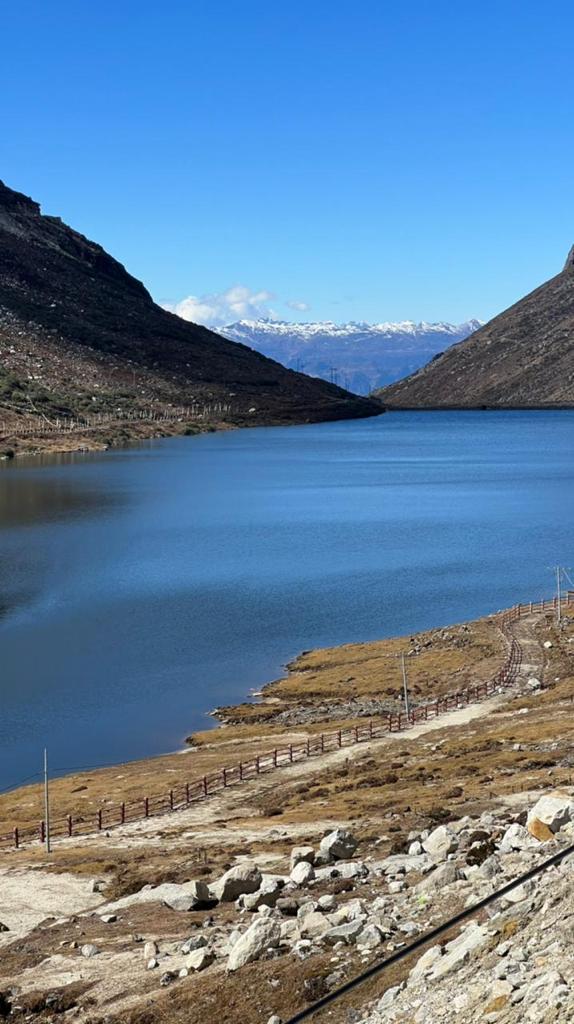Arunachal Pradesh is one of the least visited states in India for tourism, but I am sure that this is going to change very soon. It’s fresh, untouched, pure and the true Shangri-La. If one can visualise the state of bliss – then probably this place is it. Sandwiched in between Bhutan and South Tibet (China), it has an amazing mix of cultures and traditions that are waiting for you!
Sights of jaw-dropping snow-capped peaks, many folds of mountains, prayer flags fluttering in the breeze with frequents sights of Buddhist monks in their crimson robes and yaks grazing in meadows amidst temples – one feels a calmness in this fast-paced world. Could this be the Shangri-La which many travellers describe at length? A common phrase here is that “ Only heaven would have the greenest grass, the tallest snow-capped mountains, the crystal clear flowing rivers, and the freshest air.” It is literally heaven on Earth!
Living in the 21st century, one cannot imagine that there was hardly any rubbish, pollution, or cities and towns that are crowded. It borders on being eerie as there aren’t many cars or horns that mar the silence. Here you can experience the Pure Sound of Silence!
The ideal time to visit this paradise is from April till October, though many say that if you really wish to feel the spirituality, then any time of the year is good. 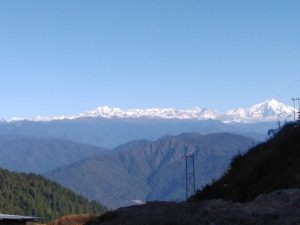 Air and road connectivity is still not very good, though the road from Guwahati to Dirang is much much better than yonder years. The nearest airport to the West Kameng province is Tezpur – unfortunately only a regional carrier – Flybig operates from Guwahati and Alliance Air from Kolkata. However, the best option at the moment is to drive 7 hours through upper Assam’s lush green countryside. Dirang itself is in the midst of snow-clad Himalayan ranges, and exudes a rustic charm and spirituality. The little village lies hidden in the West Kameng district of Arunachal Pradesh and stands as a gateway to the state’s most well-known destination, Tawang. This quaint hill town’s ever-smiling people and its picturesque scenic beauty attracts many visitors. It sure is a paradise for nature lovers, photographers as well as adventure lovers.
Air and road connectivity is still not very good, though the road from Guwahati to Dirang is much much better than yonder years. The nearest airport to the West Kameng province is Tezpur – unfortunately only a regional carrier – Flybig operates from Guwahati and Alliance Air from Kolkata. However, the best option at the moment is to drive 7 hours through upper Assam’s lush green countryside. Dirang itself is in the midst of snow-clad Himalayan ranges, and exudes a rustic charm and spirituality. The little village lies hidden in the West Kameng district of Arunachal Pradesh and stands as a gateway to the state’s most well-known destination, Tawang. This quaint hill town’s ever-smiling people and its picturesque scenic beauty attracts many visitors. It sure is a paradise for nature lovers, photographers as well as adventure lovers.
Highly recommended is a visit to the side valley from Dirang – Sangti valley. For an unforgettable experience, take a short hike of 7 kms to the valley, famous as a wintering spot for the migratory black-necked crane. Besides cranes, the charming valley is famous for kiwi, apple orchards and lush paddy fields along the pristine Sangti River. However, the main charm of the place is its people. The gentle and colourful natives of Monpa tribe have been inhabiting the village for more than 500 years with a very rich heritage of food, culture and lifestyle. It is believed that they migrated from Tibet and Bhutan though there is no written record or any account to be sure. Historically, two treaties were signed between the East India Company and Tawang in 1844 and 1853. However it is the Shimla conference of 1913-14 which was the most important event in the region’s history. In the conference, the representatives of Great Britain, China and Tibet sat together to resolve the Border issue between Tibet, China and British India. Whilst all three representatives initialled the agreement, Beijing later objected to the proposed boundary between the regions of outer and inner Tibet and did not ratify it. The Foreign Secretary of the British Indian government, Sir Henry McMahon, who had drawn up the proposal, decided to bypass the Chinese and settle the border bilaterally by negotiating directly with Tibet and thus the McMahon Line came into being. Unfortunately, the matter did not end there – as far as China was concerned.
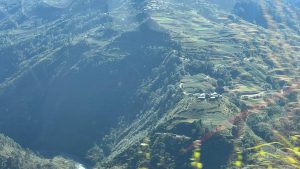
The Monpas are Buddhist by religion and follow the Tibetan Mahayana School of Buddhism, with the majority following the Gelugpa (Yellow Hat) Sect, with a small minority following the Nyingmapa (Red Hat) sect. It is said that before the advent of Buddhism in the region their religion was of a form of Shamanism generally referred to as Bon. The Bon religion believed in the existence of numerous gods and spirits. With the advent of Buddhism in the region people gradually gave up their old religion and started adopting Buddhism. However, like the Tibetans, the Monpas did not completely supplant their old religion; rather they absorbed a number of these deities into the Buddhist Pantheon as protectors of the faith and are worshipped according to Buddhist rituals. The Monpa believe in the law of Karma and follow the Wheel of Life very religiously. Strong believers of the fact that any action or deed that we do with our body, speech or mind will have a corresponding result. It is one’s karma, positive or negative, that determines one’s birth.
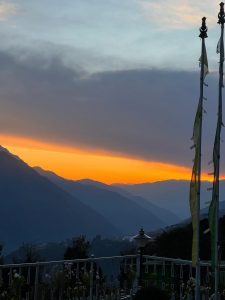 The Buddhist faith and teaching were brought by the great Master – Guru Rimpoche (Gure Padmasambhava) himself and it is from here that he went to Tibet.
The Buddhist faith and teaching were brought by the great Master – Guru Rimpoche (Gure Padmasambhava) himself and it is from here that he went to Tibet.
The road from Dirang to Tawang is through the infamous Sela pass (13700 ft). While the views of the surrounding area are nothing short of stunning, it is the tricky weather here which can be the main talking point. One minute you could be driving through calm and pleasant weather and the very next curve can be through snow and rain. Even in summer time you will see Yaks grazing lazily as there are a few settlements of the Brokpa’s (shepherds of West Kameng) around here.
Downwards from the pass and in the many mountain folds is the magnificent Tawang monastery. The famous Gaden Namgyal Lhatse roughly translated as “The peak of the heavenly abode of joyfulness and complete victory” and, popularly known as the Tawang Monastery was founded in the year 1680-81.This great place of worship happens to be the second oldest Gelugpa monastery in Asia, largest in India and second largest in the world.
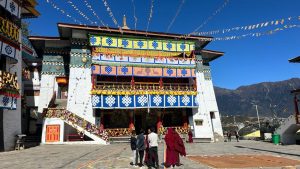
The monastery stands on the spur of a hill, about 10,000 feet above sea level and is inhabited by nearly 700 monks belonging to the Mahayana School of Buddhism. The most imposing building of the monastery is the assembly hall known as Dukhang. It is a three-storied building whose inner walls are painted with murals of various divinities and saints. The altar occupies the entire northern wall of the hall. On the left of the altar is the silver casket wrapped in silk containing the Thangkas of Goddess Sri Devi (Palden Lhamo) the principal deity of the monastery.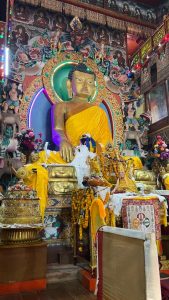 A colossal richly gilded statue of Lord Buddha occupies the middle of the northern side. It is seated on a lotus throne flanked by his two Principal attendants Maudgalyayana and Sariputra, each with a staff and begging bowl in hand. It is the largest image of the monastery and is about 25 feet high. Except for the northern wall of the hall, all the other walls are adorned with beautiful life-size frescos of various divinities and saints.
A colossal richly gilded statue of Lord Buddha occupies the middle of the northern side. It is seated on a lotus throne flanked by his two Principal attendants Maudgalyayana and Sariputra, each with a staff and begging bowl in hand. It is the largest image of the monastery and is about 25 feet high. Except for the northern wall of the hall, all the other walls are adorned with beautiful life-size frescos of various divinities and saints.
Nearby is the Ugyenling Monastery, which is the birthplace of the 6th Dalai Lama and thus is significantly important.
Two of the largest nunneries, in the region are in the close vicinity of Tawang – the Gyangong Ani Gompa (dating back to the same time as Tawang) and Bramadung Chung Ani Gompa (which is even older). However, it is the pristine beauty of these side valleys which draws a visitor in. A number of lakes and waterfalls adorn the vicinity of Tawang and a visitor is automatically drawn to them. The Sela Lake (near the Sela Pass) is generally frequent but it is the Sangetsar Tso which is as captivating, as it is unique. Surrounded by high mountains, the lake is formed due to a natural depression in the valley. Dead tree stumps jutting out of the water giving it a very eerie feel.

A great sight is also the Chumi Gyatse and the Nuranang waterfalls. Chumi Gyatse Temple is at the base of this Holy waterfall which has 108 waterfall streams and is a perfect and captivating photo. Its water is very pure and has various medicinal values.
One of the best buys one can get here is a Thangka – is a painting on cloth. The literal translation of the Tibetan word Thangka means ‘recorded message’. Amongst all the arts and crafts in Tawang, painting occupies a very special position. The most popular are the thangkas of the Wheel of Life.
Another very well-honed craft is that of mask making – mostly used in the monastic dances (Chams) now available at the crafts centre and is a must visit. Many people buy the Yellow, Red or Green masks as they represent knowledge and far-sightedness, bravery, intelligence, merit, virtue and kindness.
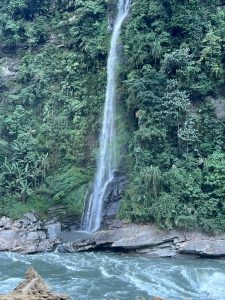 An important place frequented by Indian tourists is the Bumla pass, situated at an altitude above 15,000 feet, located approximately 37 kms. north of the district headquarters, with an approximate driving time of 2 hours. Due to its towering elevation, the pass is snowbound for almost the entire year and presents a beautiful view of the Tibetan plateau. As the Line of Actual Control (LAC) is a de-facto border, there is no border fence at the pass. On designated dates, cultural programmes are also organized by the two sides, which can be witnessed by the people. A special permit is required for visiting the Bum La Pass, which can be obtained from the local office of the Deputy Commissioner, Tawang.
An important place frequented by Indian tourists is the Bumla pass, situated at an altitude above 15,000 feet, located approximately 37 kms. north of the district headquarters, with an approximate driving time of 2 hours. Due to its towering elevation, the pass is snowbound for almost the entire year and presents a beautiful view of the Tibetan plateau. As the Line of Actual Control (LAC) is a de-facto border, there is no border fence at the pass. On designated dates, cultural programmes are also organized by the two sides, which can be witnessed by the people. A special permit is required for visiting the Bum La Pass, which can be obtained from the local office of the Deputy Commissioner, Tawang.
Tawang is a treasure trove of high altitude flora and fauna, generally not found in other parts of the state. The trees around the villages are mostly oak, magnolia, poplar, blue pine, and walnut. The oak trees are prized as they are most useful and used mostly for firewood and also in construction. Moreover it is the large variety of rhododendron which adorn the landscape during the early summer months and the colours of the flowers range from yellow to bright yellow, pink to dark pink, orange to dark red. The flowering season from April to June presents a beautiful sight as the mountain sides are full of these flowers. 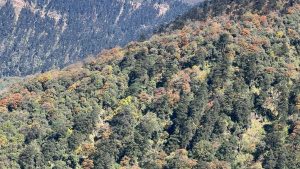
Amongst a varied fauna of these mountains is the Snow Leopard and wild Yaks which of course are found in very high altitudes. However it is the rare Red Pandas which too are sighted in the thick jungles of the lower Himalayas here.
You would do well by returning to the plains by halting at Bomdila – perched at an altitude of 3,500 metres in Eastern Himalayan Range, Bomdila is endowed with beauty all around. No wonder it is a magnet for spiritual and adventure seekers. Culture vultures would be thrilled to visit the place during Losar – the Buddhist New Year celebrations as the complete town is out to celebrate this festival traditionally. You cannot get enough of the cultural programmes, masked dance performances, various unique prayer rituals and getting a unique blend of the delicious Tibetan food and local delicacies.
Located nearly 8,000 ft above sea level, it is the perfect place for apples and orchids. Apple Orchards is a popular tourist attraction located in Tipi, Bomdila and it is Asia’s largest Orchidarium. The Orchid Glass House is the biggest attraction here and the entire orchidarium showcases almost 50,000 exotic types of the flower! Can you just imagine the beautiful sight!

The drive to Tezpur now passes through yet another beautiful place – Balukpong. The nature lover’s paradise offers a complete experience with wildlife as two very beautiful national parks – Pakhui game sanctuary and Pakke Tiger Park are not far. The Kameng River running in the forest surrounding it makes the town even more attractive. Balukpong is an outdoor lover’s paradise as one can go hiking, trekking, camping and fishing.
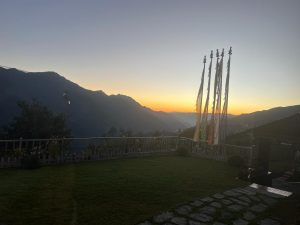
You would do well by returning to the plains by halting at Bomdila – perched at an altitude of 3,500 metres in Eastern Himalayan Range, Bomdila is endowed with beauty all around. No wonder it is a magnet for spiritual and adventure seekers. Culture vultures would be thrilled to visit the place during Losar – the Buddhist New Year celebrations as the complete town is out to celebrate this festival traditionally. You cannot get enough of the cultural programmes, masked dance performances, various unique prayer rituals and getting a unique blend of the delicious Tibetan food and local delicacies.
Located nearly 8,000 ft above sea level, it is the perfect place for apples and orchids. Apple Orchards is a popular tourist attraction located in Tipi, Bomdila and it is Asia’s largest Orchidarium. The Orchid Glass House is the biggest attraction here and the entire orchidarium showcases almost 50,000 exotic types of the flower! Can you just imagine the beautiful sight!
The drive to Tezpur now passes through yet another beautiful place – Balukpong. The nature lover’s paradise offers a complete experience with wildlife as two very beautiful national parks – Pakhui game sanctuary and Pakke Tiger Park are not far. The Kameng River running in the forest surrounding it makes the town even more attractive. Balukpong is an outdoor lover’s paradise as one can go hiking, trekking, camping and fishing.
Though the journey through “Heaven” comes to an end at Tezpur, but the memories of a lifetime will stay with you. Tezpur is a town in the foothills and frankly apart from being the closest airport to Tawang area and the awesome tea gardens which surround this town, there is not very much to see and so mostly acts as a transit point.
The State of Arunachal Pradesh is a restricted area and every non Arunachali needs permission in the form of Inner Line Permit (ILP). Getting this is not difficult at all and most tour operators can arrange for it.
So what are you waiting for ……



